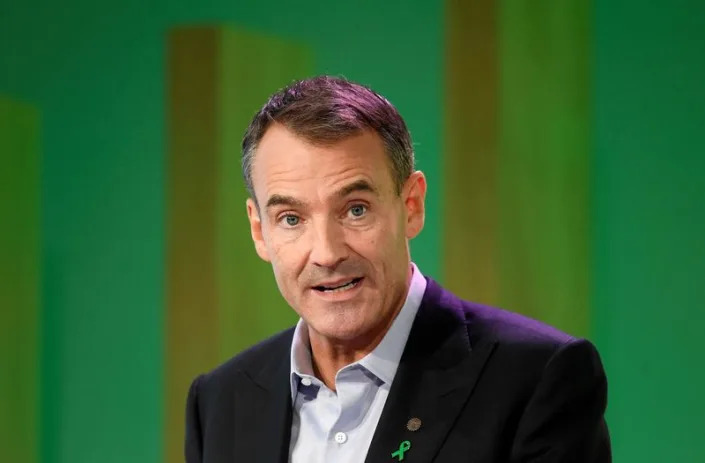


BP's new Chief Executive Bernard Looney gives a speech in central London
Mon, March 6, 2023
By Ron Bousso, Shadia Nasralla and Sarah McFarlane
LONDON (Reuters) - BP hasn't fallen out of love with renewables. It just wants to have more power.
CEO Bernard Looney's pursuit of green energy outstripped all rivals three years ago when he outlined a radical blueprint to move away from fossil fuels. Last month he applied the brakes, slowing BP's planned cuts in oil and gas and scaling back planned renewables spending in the wake of the war in Ukraine.
The oil major isn't backing away from renewables though, its green chief Anja-Isabel Dotzenrath stresses, it's simply changing the terms of the relationship.
Dotzenrath told Reuters BP was reviewing its solar and onshore wind businesses as part of a revamp that will see it move away from selling the clean electricity it produces, and instead keep hold of most of it to supply its growing electric vehicle charging network and production of low-carbon fuels.
The onshore renewables scrutiny, which hasn't been previously reported, follows reviews by Dotzenrath of BP's offshore wind and hydrogen businesses over the past year which led to overhauls that saw the company install new managers, hire staff, scrap some projects and seek to revise terms of others.
"We made some changes internally and created a focused hydrogen organisation, a focused offshore wind organisation," Dotzenrath said in an interview. "I'm (now) just reviewing the onshore renewables part - so the onshore wind and solar part."
BP's head of renewables and gas didn't elaborate on the nature of the latest review. The green stakes are high, though, given solar alone comprises more than half of BP's 43-gigawatt renewables project pipeline.
Dotzenrath also put the first numbers to BP's rebalancing act, which comes amid deteriorating profits in renewables power generation, telling Reuters that the company aimed to retain 80% of the power produced to supply the global EV network and to make "green" fuels such as hydrogen, seen by many transition experts as a key fuel of the future.
She did not give a timeframe for the shift, which represents a major pivot given the vast majority of BP's renewables output is currently linked to power grids. BP will continue to build some projects under traditional power supply deals, she added.
"We will not grow renewables for the sake of growing wind and solar," said Dotzenrath, who is marking a year in the job after joining BP shortly after Russia's invasion undermined Europe's energy security, fuelled bumper profits for oil and gas and changed the calculus of the energy transition.
"Our strategy is not necessarily about asset ownership in renewables, but it comes as a consequence. It is really about securing access to cheap - the cheapest - green electron," she added, referring to electricity from renewable sources.
IN FOCUS: VENTURE WITH EQUINOR
The most eye-popping change in the strategy update last month was BP slowing its planned cuts in oil and gas output from 40% to 25% by 2030 compared with 2019 levels.
It also lowered its projected annual spending on renewables to up to $5 billion by 2030 out of a total group budget of up to $18 billion, from $6 billion out of $16 billion under its previous update in 2022, according to a Reuters analysis.
While BP's move to produce more oil and gas for longer puts it more in line with its peers, its 25% annual reduction goal is still more ambitious than any of its global rivals.
The paring of green ambitions has been cheered by the market, with BP shares leaping about 17% since the Feb. 7 strategy update, much more than any other rival Western major.
By contrast, BP had significantly underperformed rivals since Looney outlined his industry-leading transition plans three years ago, remaining largely flat until the announcement compared with a 20% gain for Shell and 84% rise for Exxon.
The renewables revamp reflects an acknowledgement that the company won't be able to sufficiently compete with traditional power generators if it simply sells the energy produced by its wind and solar projects, according to Dotzenrath.
"It's a critical feedstock," she said. "If it is not integrated with our other businesses, we will not do this because we don't believe that we have a competitive edge."
The company's new trajectory has placed its flagship U.S. offshore wind joint venture with Norway's Equinor in the focus of managers, five sources familiar with the matter separately told Reuters.
BP executives, including Dotzenrath, have held several meetings with Equinor in London in recent weeks to discuss ways to give the oil major greater clout in the venture, said the two BP and three Equinor sources, who are close to the talks and declined to be named due to the sensitivity of the matter.
BP wants more of its staff involved in the Oslo-based venture, the people said. One of the Equinor sources with direct knowledge of the operations said BP currently had more than 20 people working on the JV projects out of a total of over 270.
Equinor declined to comment on any "speculation" about changes to the venture sought by BP. It said it looked forward to applying their combined expertise to develop projects on the U.S. East Coast. Dotzenrath also declined to comment on this.
"I am very happy with the joint venture and the progress we are making with the projects," Dotzenrath said. "These are very, very complex, large, mega projects ... we have much more ability to support Equinor in the delivery of these projects."
THAT'S THE BRUTAL REALITY
When BP paid $1.1 billion for its 50% stake in the venture to enter offshore wind in 2020, it was more reliant on the know-how of Equinor, which had over a decade of experience and specialism in the sector.
Over the past two years, though, BP has brought in hundreds of staff from renewables firms. It has also broken from its tradition of developing leaders internally and hired senior executives such as Dotzenrath, a former CEO of Germany's RWE Renewables, and an offshore wind chief from Danish giant Orsted.
The UK major surprised many investors and analysts in December when it decided not to join Equinor in bidding on a floating wind project off California. Floating offshore wind is a nascent technology that remains significantly more expensive than turbines fixed to the seabed.
"This was a portfolio decision," Dotzenrath said. "The North Sea is much more important to us and our integration story than California. I think that's the brutal reality at the moment."
(Graphic: BP's investment plans, https://www.reuters.com/graphics/BP-STRATEGY/byvrlkdzyve/chart_eikon.jpg
THE NEW NORMAL IN NUMBERS
BP's renewables revamp is underpinned by its projections about how much money it can make from the production and sale of green power versus higher-margin low-carbon businesses within its own integrated operations.
The company's outlook for its average core earnings from oil and gas in 2030 grew by around $10 billion to $42.5 billion over the course of last year, and by a meagre $1.5 billion to $11 billion from energy-transition businesses including renewables.
BP expects a return on investment of at least 15% on bioenergy including biogas as well as from combining EV charging with retail stores. Hydrogen is seen bringing in 10% returns, with renewables lagging at a maximum of 8% under the current model dominated by power sales.
While BP had a stated target in 2020 of trading 500 terawatt hours of electricity by 2030 – twice the volume in 2019 - no such target featured in its 2023 strategy update.
Dotzenrath said growth in renewables capacity would be in service to green hydrogen and other businesses it supplied internally with clean power.
"We take the green electron and do something with it," she added. "Access and control over the green electron is key because the world is short of green electrons."
Graphic: BP earnings forecasts for 2030 BP earnings forecasts for 2030, https://www.reuters.com/graphics/BP-STRATEGY/EARNINGS-FORECAST/zjpqjwlqevx/chart.png
Graphic: BP production outlook, https://www.reuters.com/graphics/BP-STRATEGY/dwpkdemrdvm/chart.png
(Reporting by Ron Bousso, Shadia Nasralla; Editing by Pravin Char)











